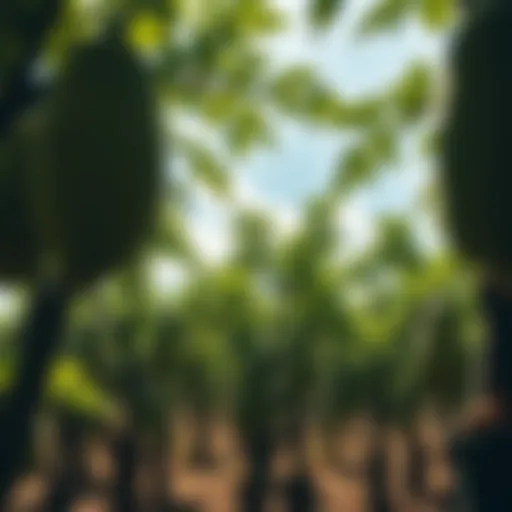Mastering the Technique of Sod Removal with a Shovel
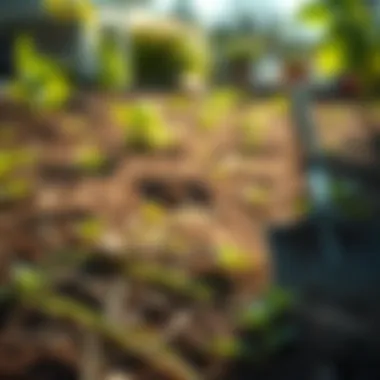
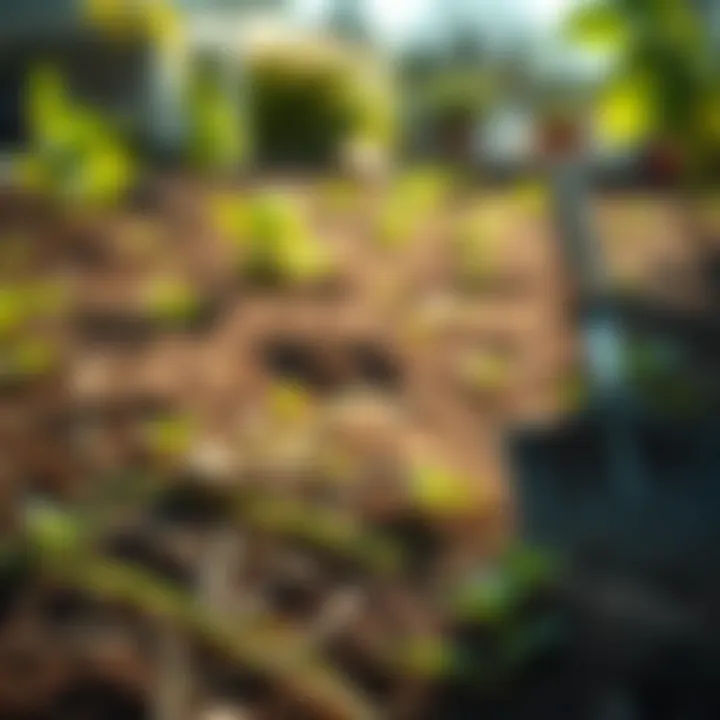
Intro
Removing sod may seem like just another chore in the garden, yet it's an intricate task that lays the groundwork for a flourishing landscape. Knowing the right techniques and understanding the tools at your disposal can make all the difference when transforming an overgrown space into fertile ground. This not only aids in your gardening endeavors but also contributes to sustainable practices that benefit the ecosystem.
The nuances of sod removal can be subtle, ranging from selecting the proper shovel to mastering effective cutting techniques. Whether you're an amateur gardener embarking on a simple project or a seasoned farmer preparing land for cultivation, this guide aims to equip you with the knowledge needed to tackle sod removal efficiently and responsibly. Let’s dive into the key concepts and terminology surrounding this essential gardening skill.
Prelude to Sod Removal
Sod removal is an essential task that often stands at the forefront of effective land preparation. It's a process that reveals not only practical techniques but also the nuances of gardening and agriculture. Understanding sod removal goes beyond merely tearing up grass; it's about creating a canvas for better soil, new plantings, and enhanced growth. In this section, we will dissect what sod is, the reasons behind its removal, and how this practice can have considerable benefits for both neophyte gardeners and seasoned farmers.
Understanding Sod
Sod refers to a layer of grass and its roots held together by soil or a fibrous web. It's often thick in areas that have been well-maintained, building a substantial mat that's tough to penetrate. As visually pleasing as sod may be, it can become a hindrance when you're looking to plant new flora or amend the soil quality. Think of sod as a protective covering that has its own set of ecosystem rules. But sometimes, these rules inhibit progress.
It's crucial to recognize that while sod plays an essential role in maintaining soil structure and preventing erosion, the same factors that make it beneficial can also stifle the growth of new crops or affect the overall health of the soil beneath it. By grasping what sod consists of, you can make informed decisions on when and how to remove it, all the while ensuring that you’re preserving the quality of your soil for future plantings.
Why Remove Sod?
Removing sod may seem like an invasive action, but in many cases, it's a necessary step in land management. Here are some reasons why one might want to take on this task:
- Soil Improvement: Beneath the sod, there can be compacted soil that needs aeration. When you remove the sod, you can improve the soil structure, allowing for better water absorption and root penetration of new plants.
- Pest and Weed Control: Existing sod may harbor pests or invasive weeds which can outcompete your desired plants. Removal can be a strategy to cut off these unsightly and often detrimental issues.
- Changing Landscape: If you're looking to make a complete overhaul of your garden, new designs want fresh starts. Removing sod can pave the way for colorful flowers, vegetables, or native grasses that suit your vision.
"Removing sod is not just about taking away; it’s about creating opportunities for what can bloom thereafter."
In essence, the act of removing sod serves as a foundational task that opens doors to healthier and more fruitful growing environments. For both agricultural farmers and enthusiasts, understanding the necessity and methodology behind sod removal is crucial for nurturing the landscape they wish to cultivate. As we progress through this guide, techniques, tools, and best practices will be elaborated upon to help streamline your sod removal efforts.
Essential Tools for Sod Removal
Removing sod is not just about muscle; it's about understanding the right tools that can ease the labor and yield better results. If one thinks they can just grab any old shovel and get the job done, they might be in for a rude awakening. Knowing what tools to reach for can save time, effort, and even back pain, making the task of sod removal not just easier, but also more efficient. Let’s dig into the tools you need to tackle this job with precision.
The Role of the Shovel
When it comes to sod removal, the shovel is the undisputed champion. It's not merely a piece of equipment, it's the cornerstone of the operation. Choosing the right type of shovel can set the stage for success. Look for a sharp-edged spade shovel, specifically designed for cutting through grass roots. These shovels usually have a narrow blade, making it easier to slice the sod precisely and with the least resistance.
It's vital to hold the shovel correctly: keep your feet shoulder-width apart, and ensure you use your legs for power rather than straining your back. Remember, a rusty or dull shovel can turn what should be a straightforward task into a tedious endurance test. A well-maintained shovel will glide through soil and roots effortlessly. To make it even more efficient, consider investing in a bulkier digging shovel for breaking up harder soil that may be beneath the sod.
"A good shovel is like a loyal friend; it’s always there to back you up when you need it the most."
Additional Equipment Needs
While a good shovel is central to the process, relying on it alone may not be sufficient for a thorough knee-deep job. Consider gathering a few additional tools that could come in handy:
- Garden Rake: Useful for smoothing the soil once the sod is removed. It helps to level out the area for future planting or landscaping.
- Sod Cutter: If the project is on the larger side, a sod cutter can be a game-changer. This tool allows for quicker and cleaner cuts, minimizing effort and maximizing results. For those willing to rent, it pays to look into the mechanical versions that can cut wide strips of sod in a fraction of the time.
- Wheelbarrow: For hauling away the sod or transporting tools, a sturdy wheelbarrow can be the unsung hero of any garden project.
Lastly, synthesize your safety gear as well—gloves, knee pads, and maybe even a good pair of boots, especially if you’re tackling a large area. So, don’t shy away from investing a little time and money into ensuring you’ve got the right tools at your side.
Preparing the Area
Before diving headfirst into the sod removal process, laying the groundwork is key. Preparing the area not only sets the stage for smoother execution but also ensures that the removal is done efficiently and effectively. It’s much like getting your ducks in a row; a little foresight can save a mountain of trouble later.
Assessing Soil Condition
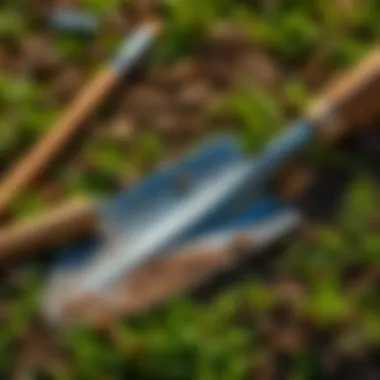
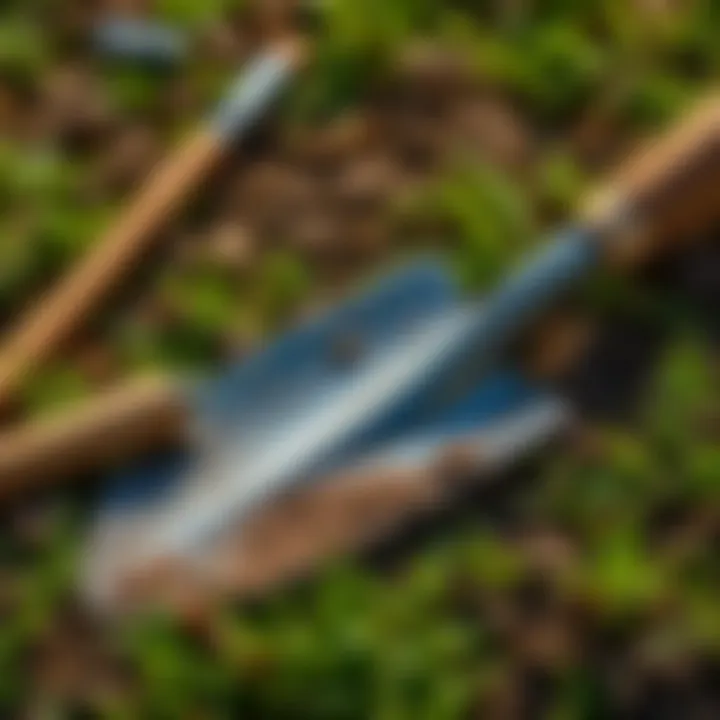
One of the first steps in preparing your area for sod removal is to assess the soil condition. This means you need to get your hands dirty – literally. Start by checking how compact or loose the soil is. If you find a dense, hard base, that might be your first red flag. Compacted soil can make it a bear to remove sod, as it creates resistance against your efforts.
Take a spade and dig a few test holes around the area you plan to tackle. If you come across more clay than sand, or if the soil seems overly dry or soggy, you’ll need to rethink your approach. Perhaps consider soaking the area a day before removal if it’s overly dry, or waiting for the ground to dry out a bit if it’s too wet. This awareness helps in determining the right timing and methods for removal.
Also, keep in mind that healthy soil often contains a mix of air, water, minerals, and organic matter. If you notice signs of poor health, like an unusual abundance of weeds or a difficulty in root penetration, you might want to amend the soil before proceeding. This could mean aerating the soil or mixing in former compost to enrich it for future planting.
Marking Boundaries
Next up, marking boundaries is an essential stage of preparing your area for sod removal. No one wants to start digging only to discover they’ve bitten off more than they can chew. This part is as straightforward as it gets; you need to outline where you want to remove the sod.
Using stakes or small flags, delineate the area clearly. You can even use spray paint if you prefer a more visible mark. This helps in maintaining focus and ensures you don’t end up cutting out areas that were meant to stay untouched. If you’re working on a larger plot, it might be wise to create a map or a simple diagram showing your layout.
Moreover, it’s handy to take some time to plan what will happen after the sod is gone. Will it be a garden bed? A new lawn? Knowing your end game can make your boundary marking even more efficient, ensuring that you achieve the desired aesthetic and functional outcome when the dust settles.
"Preparing the area meticulously can mean the difference between a laborious task and a smooth operation, facilitating a handyman's dream of a tidy garden space."
Techniques for Effective Sod Removal
The process of sod removal can often feel daunting. However, mastering effective techniques is pivotal not just for ease but for achieving optimal results when preparing your land for new vegetation. Right. You don't just want to pull up grass; you want to ensure that what comes next has a fighting chance. That's where techniques become crucial.
First off, it’s important to seek a method that minimizes damage. This is vital for those thinking about the health of their soil and future plantings. Using the right techniques can save time, energy, and even prevent soil erosion that might come from a hasty removal.
Now let’s drill down into the specific techniques you'd employ.
Cutting the Sod
Cutting the sod is like making the first incision in anything—a foundational step that can dictate the success of the entire operation. To kick things off, a sharp shovel or even a sod cutter can do wonders here. The goal? You want to create a clean separation between the sod and the soil beneath it. Taking a moment to slice through the roots as well will make lifting much easier later on.
When you're out there, mark out your intended area with stakes or a garden hose, giving you a visual guide. Start at one end, insert your shovel blade at a slight angle, and make your cut about four inches deep. It’s an art, really.
"Taking your time now can save you hours of back-breaking work later on."
Try to work in sections, maybe about three feet wide. This way, you avoid overwhelming yourself and can focus on precision. If you’re attempting to remove sod from uneven ground, bending your knees and maintaining a steady grip can aid in achieving those clean cuts.
Lifting the Sod
Once the sod is cut, the next step is lifting it. This is where your muscles will get their workout. To lift effectively, start at one edge of your previously made cuts. Using your shovel, pry up an end before pushing down with the handle to get leverage. A good tactic is to position yourself at a slight angle to allow for easier upward motion.
Whether you're lifting a small section or a large chunk, keep your core engaged. You'd be surprised how much this can protect your back. If you’re faced with a section that refuses to budge, you might have to go back to snip away at any lingering root connections.
Another handy tip? If the sod is thick or tough, spraying some water on it a few hours before you get started can soften the soil, making lifting easier.
Handling Large Pieces
Handling large pieces of sod can feel like wrestling an alligator; you need strategy and a bit of finesse. With these larger sections, it’s best to work in pairs if possible. While one person lifts, the other can help maneuver and control the weight. If you're alone, consider using a rolling method—simply begin at one end and roll it over. Less strain and keeps the material intact.
Also, if you plan on reusing the sod, be gentle. Rough handling can tear it apart and create unwanted gaps in your lawn down the line. Stack your lifted sections neatly if you plan to move them elsewhere. Not only does this help in keeping the area tidy, but it also allows air to circulate.
By employing these techniques intelligently, you’ll transform sod removal from a messy task into a structured process. Mastering these skills will not only yield better results but will also enhance your overall gardening prowess.
Best Practices during Sod Removal
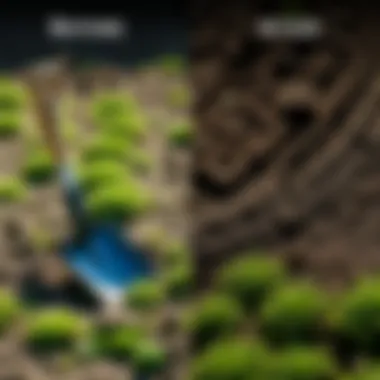

When it comes to removing sod, doing it right can mean the difference between a successful land preparation and a grueling headache later on. Best practices aren’t just guidelines; they help ensure that the process is as smooth as possible while also yielding beneficial outcomes for the soil and any future planting endeavors. This section provides insight into effective working techniques and safety considerations that should be kept in mind during sod removal.
Working Techniques for Efficiency
Efficiency in sod removal can significantly cut down on time and effort, allowing one to get to the more enjoyable parts of gardening or landscaping. Here are some practical techniques aimed at helping you work smarter, not harder:
- Plan Ahead: Before you even pick up your shovel, take a few minutes to plan your approach. Identify the measurement of sod you need to remove and sketch out a rough plan on how you'll proceed. This helps prevent doubling back on steps or missing areas.
- Moisten the Soil: If the soil is dry, consider watering it a day before you start. This will make cutting through the sod much easier, as moist soil tends to loosen up the roots and makes lifting less laborious.
- Use Straight Cuts: When you’re slicing through the sod, make long, straight cuts. This technique not only helps you maintain control but also allows you to lift larger pieces, leading to a quicker removal process.
- Work in Sections: Instead of trying to tackle a big area all at once, break it down into smaller sections. This not only helps keep the task manageable but also allows for more focus and care in the removal process.
- Employ the Right Angle: While lifting, angle the shovel’s blade to help pop the sod up with less force. A slight tilt can make a world of difference when trying to dislodge stubborn pieces.
By adhering to these techniques, you not only increase your efficiency but also protect the soil for any future usage.
Safety Considerations
Safety during sod removal should never be an afterthought. Poor technique or lack of caution can lead to injuries that far outweigh the benefits of a job well done. Here are some key points to consider:
- Proper Footwear: Wearing sturdy boots or shoes with good grip can prevent slips and accidents while working, especially if the ground is uneven or wet.
- Use Correct Lifting Techniques: When lifting sod, bend your knees and keep your back straight. This reduces the risk of strain and makes lifting easier.
- Stay Hydrated: Working outdoors can be exhausting, especially under the sun. Make sure to drink plenty of water to stay hydrated and avoid fatigue.
- Watch for Roots and Other Obstacles: Pay careful attention to what you are digging into. Roots, large stones, or other debris can be hazardous and can potentially lead to injury. If you encounter such barriers, take a moment to reassess how to proceed safely.
Remember: A safe worker is an efficient worker. Pay attention to your body and surroundings at all times to prevent unnecessary injuries.
Practicing these safety measures can turn a demanding job into a manageable project, setting the stage for a fruitful gardening season ahead.
Following these best practices will significantly enhance your sod removal process by fostering an efficient, safe, and effective environment. Whether you are preparing for a new lawn or another landscape feature, being smart about your approach goes a long way.
Post-Removal Actions
Once the sod is removed, the next steps become paramount in determining the overall success of your gardening or landscaping project. These post-removal actions not only facilitate a smoother transition from sod to your intended use of the space but also play a vital role in maintaining soil health and ensuring a thriving ecosystem. Below are key considerations and actions to take following sod removal.
Disposing of Sod Responsibly
Responsible sod disposal can be a bit of a puzzle. It is essential not to treat removed sod as just waste. Sods often contain valuable nutrients and organic matter that can be reused. Here are a few ways to handle sod disposal:
- Composting: If you have a sizeable amount of sod, composting can be an excellent option. Layering sod in a compost pile allows microorganisms to break down the organic material, ultimately enriching your garden soil.
- Mulching: Shredded sod can be used as mulch. Applying it around plants retains moisture, regulates soil temperature, and suppresses weeds, making it a double-duty solution.
- Local Green Waste Programs: Some communities have programs for green waste disposal, where you can drop off sod or have it picked up. This not only helps in recycling but can contribute to community composting efforts.
Keeping these options in mind, you can turn what could be waste into a resourceful asset for your land.
Soil Preparation for Future Use
After the sod is gone, the soil underneath needs attention. The process of soil preparation can determine how well your next planting goes. Here are some steps you should consider:
- Testing Soil Quality: Begin with a soil test to check pH levels, nutrient concentration, and soil type. This will help you understand what amendments may be needed.
- Amending the Soil: Depending on the soil test results, you might need to add organic matter, such as compost or aged manure. This aids in improving soil structure and fertility, leading to healthier plants.
- Aeration: If soil compaction was a problem prior to sod removal, now’s the time to aerate. Using a garden fork or mechanical aerators can improve drainage and root penetration in the soil.
With appropriate soil preparation, your new planting endeavors stand a much better chance of thriving.
Planting Considerations
As you gear up to plant after sod removal, several considerations can enhance your success:
- Timing: The timing of your planting matters a great deal. Pay attention to local climate conditions and seasons. Planting during optimal times can lead to better growth rates and fewer pests.
- Choosing Native Plants: When selecting plants, consider adapting the natives. They usually require less maintenance, water, and are more resilient to local pests and diseases.
- Spacing and Layout: Plan your layout carefully. Too close and you might create competition for resources; too far apart and you may not utilize the space effectively. Consider the mature size of the plants.
Proper planning during the planting phase sets the foundation for a flourishing landscape, allowing your efforts in sod removal to yield fruitful results. Remember, all these actions intertwine to promote not just individual plant health, but the overall ecosystem’s vitality.
Sustainability in Sod Removal
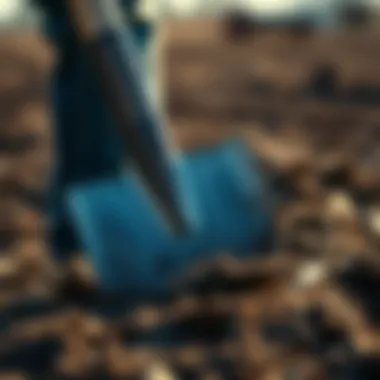
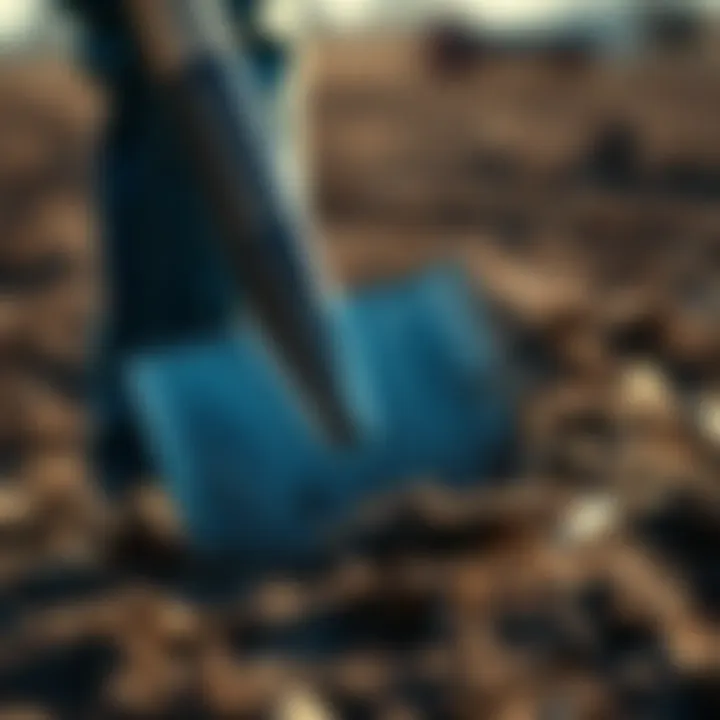
Sustainability plays a crucial role in the process of sod removal, serving as a bridge between necessary agricultural practices and the health of our ecosystems. Removing sod isn’t just about clearing land; it’s about doing so in a way that promotes long-term benefits to the soil, plant life, and local environment. Understanding the sustainability aspect of sod removal can help farmers and gardening enthusiasts transform their methods into environmentally friendly practices.
Impact on Soil Health
When sod is carefully removed, one of the most significant benefits is its positive impact on soil health. Soil is a living entity, teeming with organic matter and microorganisms that are essential for plant growth. However, when sod is stripped away improperly, it can lead to several problems.
Proper sod removal can improve soil aeration and drainage while retaining essential nutrients. With roots left undisturbed, beneficial bacteria can continue to thrive and enhance nutrient cycling. Here are a couple of aspects to consider:
- Reducing Compaction: When sod is removed using proper techniques, it aids in reducing soil compaction. Compacted soil restricts root growth and water infiltration, while a well-tended soil structure allows air, water, and roots to penetrate more easily.
- Maintaining Microbial Life: The transition from sod to a new planting area should occur with care, ensuring that the natural balance of microorganisms remains intact. This can be done by not disrupting soil too disturbingly during sod removal. The health of microorganisms is vital because they play a part in decomposing organic materials, helping to create a rich soil structure that benefits subsequent crops.
"Healthy soil is the cornerstone of sustainable agriculture; it’s where the magic happens!"
Native Grass Restoration
Restoring native grass species post sod removal is another essential slice of the sustainability pie. Native grasses are not only adapted to local conditions but also provide numerous ecological benefits. When sod is removed, replacing it with native grasses boosts biodiversity and helps restore the local ecosystem.
Consider the following benefits of native grass restoration:
- Enhancing Biodiversity: Native grasses support a wide range of wildlife, including birds, insects, and other organisms. By creating an environment rich in native species, we contribute to the broader health of the ecosystem.
- Erosion Control: Native grasses have extensive root systems that prevent soil erosion. This natural barrier safeguards soil during rainfall or wind events, keeping your land and waterways clear of excess sediment.
- Water Conservation: These grasses generally require less water compared to non-native species. By incorporating them into your landscape, not only do you conserve water, but you also foster a habitat that thrives with minimal human intervention.
In summary, sustainability in sod removal hinges on understanding how to manage soil health and promote native flora. It's not merely about removing strip after strip of turf; it's about nurturing the earth for future generations. By adopting sustainable practices, agricultural farmers and enthusiasts can use sod removal as a stepping stone to better land management—making it better for the plants, animals, and for us.
Common Challenges in Sod Removal
Removing sod is fraught with its challenges. The right approach not only affects the efficiency of the work but also the final outcome in garden or field preparation. Understanding these hurdles allows for better preparation and execution. By getting a handle on what to expect, you can tackle sod removal without feeling like you're wrestling an alligator.
Dealing with Tough Root Systems
One of the biggest enemies when removing sod is the root systems that dig their heels in like a stubborn mule. Depending on the type of grass, some roots grow deep and can easily anchor themselves within the soil. You might think you’re making progress only to discover that the most tenacious roots remain behind, clinging to the soil with a grip that feels unyielding.
To tackle these tough root systems, you’ll need two tools: patience and a sharp shovel. Before starting, examine the area for signs of deep roots, such as thick clumps of grass or large, woody roots. For certain grasses, it may help to wet the area ahead of time, which can soften the roots and make them easier to cut.
When you encounter an especially stubborn root, try using the shovel as a lever. Insert the shovel blade beneath the root, and then apply some quick upward force, effectively prying it free. More often than not, the root will finally give way. A deliberate approach can also minimize damage to the surrounding soil, preventing future issues with uneven ground.
Addressing Soil Compaction
Another elephant in the room during sod removal is soil compaction. Compacted soil is like concrete, making the task of lifting sod feel ten times more laborious than it should. It's often the result of foot traffic, heavy equipment, or long-term agricultural use. Compacted soil can inhibit drainage and nutrient absorption, which is counterproductive, especially when you're trying to prepare the land for new planting.
Before you dive into the removal process, take a moment to assess the condition of the soil. If it feels like you’re stepping on a brick, it’s wise to use a garden fork or aerator to break it up a bit. This allows air to flow through and makes the sod easier to lift. The best strategy is to work in sections, loosening compaction one area at a time.
Shoulder some of that physical burden by using liquid soil amendments, like a biostimulant. Not only can this help revitalize the soil, it can have a positive impact by promoting the growth of beneficial bacteria, ultimately enhancing soil structure. Think of this step as setting the stage before the big show – it can make all the difference.
By arming yourself with knowledge of these challenges, you set the groundwork for a smoother and more effective sod removal process. Remember, each obstacle is just a stepping stone toward achieving a thriving garden or farmland.
Culmination
Removing sod is more than just a necessary chore in land preparation; it's an art that requires careful consideration and technique. As discussed throughout this article, the act of sod removal plays a pivotal role in establishing a thriving landscape—whether for a garden or a larger agricultural venture. Its importance cannot be overstated, as it begins the cycle of healthy growth, allowing for the cultivation of diverse flora that can rejuvenate both soil quality and overall land use.
Reflecting on the Technique
Thinking about the techniques shared, the use of a shovel not only signifies a physical effort but also embodies a mindful approach to land stewardship. It requires an understanding of the nuances of soil layers and root systems, which can differentiate a successful sod removal from a failed attempt. By effectively cutting and lifting sod, one can maintain the integrity of the underlying soil while preparing for new crops or planting. It’s about respecting the land, engaging with its textures and challenges rather than battling against them. Without this recognition, future horticultural endeavors can suffer greatly from misshaped earth and poor nutrient retention.
Future Implications for Best Practices
Looking ahead, the techniques and approaches outlined can drive better practices within the community of agriculture and gardening enthusiasts. As sustainable practices take center stage, the methodologies employed in sod removal must adapt to incorporate environmentally friendly processes. Future generations should focus on enhancing soil health, fostering biodiversity, and utilizing native plants to restore ecosystems disrupted by traditional agricultural methods. Implementing these best practices not only promotes aesthetic value but also ensures longevity in land productivity. Thus, by evolving the techniques of sod removal, the agricultural community can create a lasting impact on both the environment and farmer livelihoods.
By following the discussed techniques and principles, individuals involved in landscape management can look forward to a more sustainable and productive future. For further reading and practical advice resources, visit Wikipedia or check out forums on Reddit for discussions related to sod removal and sustainable practices.









